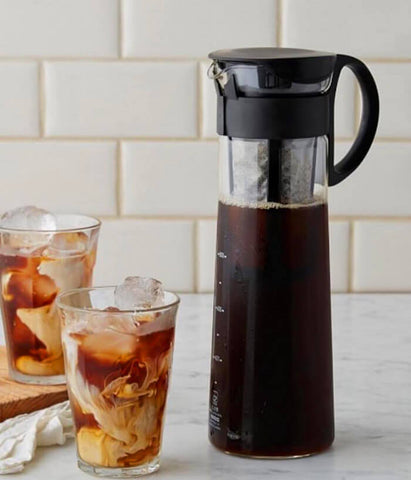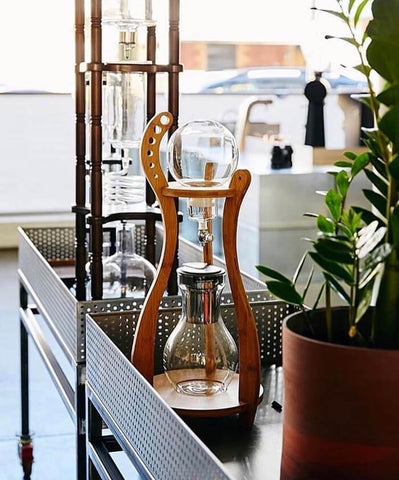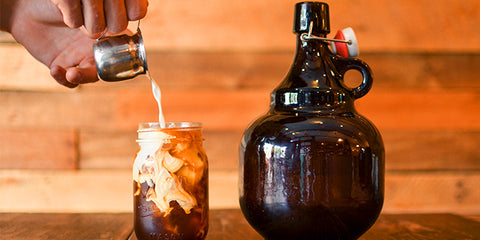
Cold Brew vs. Cold Drip Coffee - What's The Difference?
You may well have already have fallen in love with cold brew coffees, and if so you might be thinking about trying cold press coffee yourself at home. You may not be aware of what exactly the difference between cold brew and cold drip coffee is. With such an array of cold brew coffee recipe available on the internet, it’s no wonder people are a little confused. If you want to know the secret to the best cold brew coffee, and what is the difference between cold brew and a cold drip, then we wrote this article for you. We’ll show you how are they made, how and why they taste different from one cup of hot brewed coffee (and each other), and most importantly how easily cold press coffee can be prepared at home with ground coffee from the grocery store.
What Is Cold Brew Coffee?
 Cold brew coffee is, as the name suggests, to make cold brew coffee that is brewed in cold water (use filtered water for best results) with ground coffee from coffee beans. Which you probably knew already. What you might not know though exactly how the cold press coffee process works and why the coffee produced tastes so different. Conventional hot coffee brewing methods use hot water (filtered water) to accelerate the extraction process, which is why to make cold brew coffee takes so much longer. The slower and more gentle extraction has a profound effect on the final flavour of the coffee beans, as cold water extracts less fatty oils and acids than hot water, which results in a less bitter, and sweeter brew.
Cold brew coffee is, as the name suggests, to make cold brew coffee that is brewed in cold water (use filtered water for best results) with ground coffee from coffee beans. Which you probably knew already. What you might not know though exactly how the cold press coffee process works and why the coffee produced tastes so different. Conventional hot coffee brewing methods use hot water (filtered water) to accelerate the extraction process, which is why to make cold brew coffee takes so much longer. The slower and more gentle extraction has a profound effect on the final flavour of the coffee beans, as cold water extracts less fatty oils and acids than hot water, which results in a less bitter, and sweeter brew.
The coffee and water are placed together in a vessel, and then you should make sure that the coffee is then left for up to 24 hours to extract into the cold water, normally in a refrigerator (to control the temperature). You can also use a cold drip or cold brew coffee maker to make cold brew coffee. The best cold brew ratio of coffee to water is generally considered to be somewhere between 1:7 to 1:8, and your decision here should affect the brew time also. You'll need to experiment in order to find the best recipe to make cold brew coffee for you, as well as experimenting with various coffee beans. Just don't forget the cold water.
Once the time is up, a sieve or heavy coffee filters are used to remove the coffee grains, which after several repeats leaves you with cold brew coffee. If you’d like to make cold brewed coffee at home, a custom made home cold brewer like the Hario Cold Brew Bottle removes the need for extra filtering.
Is Cold Brew Stronger Than Regular Coffee?
It’s hard to give a straight answer to this. In terms of the coffee you produce, yes, it will have a higher caffeine content, but as cold brew is generally treated as a cold brew concentrate and served diluted (like a cold brew espresso), it would depend entirely on how much additional cold water you add to your cup.
Why Does Cold Brew Coffee Taste Better?
Cold water extracts less fatty oils and acids from the coffee, which in turn means the taste is less acidic and bitter than a hot coffee. It is estimated this create a brew with around a third of the amount of acid found in a hot coffee. This allows the sweeter and more floral notes present to come to the fore as they are no longer suppressed by the acidic, bitter and sour tones which extract during hot coffee making, resulting in a much sweeter cup of coffee. This difference in cold water extraction, however, may need to be factored in when choosing the best cold brew coffee beans.
Why Is Cold Brew Better for You?
I’m sure as hardened coffee drinkers we’ve all experienced that one cup too many which can make your stomach flip, and the reason that happens is acid. Additional acid is the stomach’s enemy, as it already has quite enough of it. So, for the reasons we’ve just stated above, the lack of acid means to make cold brew is better for your digestive health and so in the short to long term will benefit your overall wellbeing.
What Is Cold Drip Coffee?
 Cold drip coffee uses a system of three beakers (normally). There’s a very good chance you’ve seen a cold drip tower as the centrepiece in a coffee shop, such is the popularity of this style of brewing at present. There are many models available for the home which take up way less space like the Bruer Cold Brew System. The principal is the same; the first beaker contains water which is drip controlled to very slowly release cold water into the coffee grounds. Once the grounds are saturated they will then start to slowly drip the coffee into the final beaker, creating a darker, more intense cold coffee. Whereas immersed cold brew concentrate produces a light floral coffee cold brew, cold drip will result in a more intense coffee concentrate, although still sweeter than coffee brewed with hot water.
Cold drip coffee uses a system of three beakers (normally). There’s a very good chance you’ve seen a cold drip tower as the centrepiece in a coffee shop, such is the popularity of this style of brewing at present. There are many models available for the home which take up way less space like the Bruer Cold Brew System. The principal is the same; the first beaker contains water which is drip controlled to very slowly release cold water into the coffee grounds. Once the grounds are saturated they will then start to slowly drip the coffee into the final beaker, creating a darker, more intense cold coffee. Whereas immersed cold brew concentrate produces a light floral coffee cold brew, cold drip will result in a more intense coffee concentrate, although still sweeter than coffee brewed with hot water.
How Long Does Cold Drip Coffee Take?
Depending on the size of the machine, a full batch of cold drip can take anywhere from 3 to 24 hours. Shorter brews generally will produce a less intense cup as the extraction time is shorter, which may well be to your taste, but there are a number of variables, as with all brew methods, which will affect this, such as the size of the ground coffee used and the temperature of the water. Generally though cold drip can be produced faster than making cold brew coffee.
Differences Between Cold Brew Vs. Cold Drip Coffee
Despite both coffees being brewed cold, there are in fact surprising differences between the resulting brews. The method of preparation is quite different, as are the processes by which the flavour is extracted, and each requires different brewing times, different equipment, grind size, and produces coffee of different strength, taste and flavour. Of course, taste is also determined by your choice of coffee beans.
Brewing Method

Here's a cold brew recipe: to produce cold brew coffee, water and coarsely ground coffee grounds are mixed together in a vessel and essentially left to stew over a long period of time. The resulting coarsely ground ground coffee soup is then strained and filtered with paper filters several times to remove as many of the coffee grounds as humanly possible, although generally a small amount of sediment remains, and people actually prefer this as it lends a chocolatey, sweet flavour and ‘mouthfeel’. As we mentioned earlier though, modern cold brew coffee makers like the Hario Cold Brew Pitcher remove the need for filtering ground coffee, making this a super easy preparation method.
Cold drip coffee is a more scientific process and visually more exciting. Water is dripped very slowly from the top beaker into the ground coffee, which then absorb this slowly until they can take on no more, at which point coffee begins to drip through a coffee filter into the beaker below. This produces a pre-filtered coffee which is more intense than making cold brewed coffee.
Brewing Time
For cold brew coffee, it is generally recommended it be left to brew for at least 12 hours (or overnight) but there is no real consensus as to exactly how long you should brew for; with so many cold brew recipes floating around, this really depends first on taste and other variables like water temperature and the size of your ground coffee rather than the 12 hours rule. It is generally accepted that 24 hours is around the maximum brew time, however.
Cold drip coffee can be made in as little as 3 hours, or as long as 24 hours. As there are more variables that can be played with and the set up is more precise, the timescales can be more variable too. Generally, cold drip can be produced faster, but for your taste, you may opt for a much longer brew time.
Coffee Strength
 Cold brew coffee may well work out the stronger of the two in it’s ‘raw’ form, but as it is treated as a cold brew concentrate and used as the base for many iced coffee, much like the espresso roast is for hot brews, when served it will be diluted and so work out weaker by volume. Cold drip coffee is generally served straight over ice cubes with no additional water, and so although you’ll be drinking a smaller cup of iced coffee, the ration of caffeine to water will be higher.
Cold brew coffee may well work out the stronger of the two in it’s ‘raw’ form, but as it is treated as a cold brew concentrate and used as the base for many iced coffee, much like the espresso roast is for hot brews, when served it will be diluted and so work out weaker by volume. Cold drip coffee is generally served straight over ice cubes with no additional water, and so although you’ll be drinking a smaller cup of iced coffee, the ration of caffeine to water will be higher.
Taste and Flavour
Both brews will taste noticeably less acidic and bitter than brewing espresso, drip or other hot brewing methods. Cold brew coffee should be the lighter of the two, refreshing and with easily discernable sweet and floral notes. It works best as a base for iced coffee and will generally be diluted. It will almost always be served black. Cold drip coffee, although still way less acidic than hot coffees made with boiling water, will taste a little more full-bodied and rich like brown sugar, but will still be delightfully sweet and floral. Cold drip coffee tends to lose a lot of complexity when diluted so will normally be best served straight over ice. If you prefer milk in your coffee of the two this will stand up the best, as the stronger flavour will still carry through the milk, whereas making cold brew may lose the more subtle flavours which complete its taste.
 Equipment Needed
Equipment Needed
So clearly both methods require different equipment. Although cold brew coffee can be made at home with a mason jar, a paper filter or cheese cloth, measuring cup and ground coffee, this is a pretty hit and miss approach, so we recommend using one of our custom made cold brewers, like the Hario Mizadushi Cold Brew Coffee Pot 1L (or slightly smaller, 600ml Hario Cold Brew Pot) which not only give you a greater degree of control but are also designed to remove the need for extra filtering with a paper filter.
Cold drip coffee is a slightly more precise art and as such definitely requires more specialised equipment. The process is generally quicker and the awesome Dripster Cold Brew Coffee Maker can produce excellent cold drip coffee in as little as three hours!
Which Cold Brew Should You Choose?
Well the honest answer here is that’s it’s totally up to you! Both brews will provide you with a mellower, less acidic brew which is not only a sweeter, lighter and more refreshing but better for your gastric health. If you prefer a more full-bodied, shorter drink, or if you prefer to take your coffee with milk, then a cold drip machine might well be for you. If you like a longer, sweeter drink then cold brewing could well be your ‘thing’. So the method of making cold brew you go for will, and should, depend on your taste! Once you’ve made your mind up, be sure to browse our range of cold brewers where we’ll sure you’ll find just the thing to get started cold brewing and brew coffee at home yourself.
 Same Day Dispatch
Same Day Dispatch
 Equipment Needed
Equipment Needed